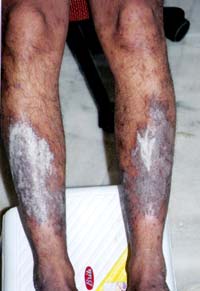What is psoriasis?
The term psoriasis comes from the Greek word psora, which means, “to itch.” However only 50% psoriasis patients have itching. Psoriasis is a chronic (long-lasting), non-contagious skin disease, usually presenting with red patches covered with silvery scales. Some 10 – 30% of psoriasis sufferers also experience inflammation of the joints called psoriatic arthritis.

Psoriasis on abdomen before treatment

Psoriasis on abdomen after treatment
How do I treat psoriasis?
I use Narrow Band UVB phototherapy and UVA phototherapy in combination with oral psoralens to treat psoriasis. I also use tar, dithranol, salicylic acid, calcitriol, topical corticosteroids and tazarotene ointments. I have extensive experience with methotrexate, cyclosporin A, acitretin, and apremilast use in psoriasis and have also received specialized training in the use of biologic agents e.g. adalimumab, etanercept, infliximab, secukinumab and ustekinumab in the treatment of psoriasis. Recently topical and oral JAK inhibitors have also become available for the treatment of psoriasis.
Are there different types of psoriasis?
Psoriasis may affect different parts of the body and also look different in different areas.
Discoid or plaque psoriasis – Silvery, scaly areas are seen usually on the elbows, knees, scalp and trunk.
Nail psoriasis – There is loosening, lifting, discoloration and thickening of the nails.
Scalp psoriasis – There may be dandruff-like scales or thick scabs on the scalp. These may be the first sign of psoriasis in the patient.
Guttate psoriasis – This usually occurs in children after a streptococcal sore throat. Small pink areas of scaling, resembling raindrops, are seen on the trunk.
Flexural or inverse psoriasis – This type of psoriasis appears as glazed red patches without scaling in the armpits and groins and under the breasts.
Napkin psoriasis – This appears as glazed red patches in the napkin area in babies.
Generalised pustular psoriasis – At first there is reddening of the skin all over the body. Then small pustules appear on the skin. Soon there are lakes of pus under the skin. The patient has high fever and a rapid pulse. He / she needs quick hospitalization, as the condition is life- threatening.
Generalised erythrodermic psoriasis – There is redness and scaling all over the body with accompanying fever and lymph-node enlargement. Like generalized pustular psoriasis, this condition is also life-threatening and the patient needs immediate hospitalisation.
Palmoplantar pustulosis – There are deep-seated pustules and dark red crusts on the palms and soles.
Psoriatic arthritis – The joints of the fingers, toes, spine and hips are affected.

Psoriasis on legs before treatment

Psoriasis on legs after treatment
What is the cause of psoriasis?
Psoriasis is a skin disorder driven by the immune system, especially involving a type of white blood cell called a T cell. Normally, T cells help protect the body against infection and disease. In the case of psoriasis, T cells are put into action by mistake and become so active that they trigger other immune responses, which lead to inflammation and to rapid turnover of skin cells.
Some people carry genes, which make them more prone to develop psoriasis. Those who already have psoriasis in the family carry these genes on chromosome 6, others on chromosome 8.
The following can also trigger off psoriasis: –
Emotional stress
Injury to the skin
Streptococcal throat infection
Drugs e.g. anti-malarials like chloroquine and mefloquine, blood pressure lowering agents like beta-blockers, calcium channel blockers and captopril, painkillers like aspirin, cholesterol lowering agents like gemfibrozil, psychiatric medicines like lithium, systemic steroids and alcohol intake.
Is there a cure for psoriasis?
There is as yet no cure for psoriasis but with the various available treatment options, it is possible to clear psoriasis for periods of time. With the development of biologic treatments, a cure may be round the corner.
How effective is ultraviolet light therapy?
Ultraviolet light or UV light is used for more extensive skin involvement. This form of treatment is very successful and perhaps safer to use than many of the oral medications.
What forms of UV phototherapy are usually given in psoriasis?
UVA phototherapy, usually in combination with psoralen tablets and narrow-band UVB phototherapy (NBUVB) usually without psoralen tablets, are often used for treating psoriasis.

Psoriasis on elbows before treatment

Psoriasis on elbows after treatment
Can UVA and NBUVB light be used to treat other skin diseases?
Apart from psoriasis, these special wavelengths of light can be used to treat vitiligo, atopic eczema, lichen planus, alopecia areata, persistent itching, pityriasis lichenoides and many other not so common skin diseases.
Are there risks with the pills used for psoriasis?
Most of the pills that are used to treat psoriasis carry risks. These risks mostly involve either the liver or the kidney. Monitored correctly, the risk can be well controlled and the medications often allow for significant improvement. Should treatment with these medications be necessary, I will be happy to discuss their risks and benefits with you in detail.
